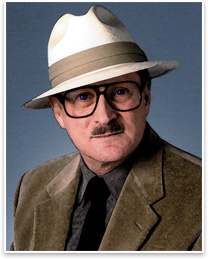
H. Edward Goldberg, AIA Summary: With more than 30 years’ experience as an architect and industrial designer, Ed Goldberg, AIA, is one of the leading authorities on architectural technology. He served as coordinator of CAD and Multi-Media at Carroll Community College from 1994-1999 and as coordinator of the Industrial Design Program at Towson University from 2000-2003. Goldberg has conducted lectures and workshops at AIA components and the annual convention, Autodesk University, AEC Systems Expos, and AEC/ST. He writes extensively on technology in CADALYST, Architecture Business & Economics, and the Inside AutoCAD newsletter. He is the author of six books.
Latest achievement: Writing in the magazine: I think I am the leading authority on computing for architects. I have approximately 120,000 readers in CADALYST. Greatest asset: My greatest asset is my ability to communicate and instantly create relationships. I love to talk to people. If I’m at a party and there are 100 people in the room, by the end of the night I will have talked to those 100 people and will know a lot about [them]. In return, that kind of quality is what has put me where I am. It is the reason why I am in demand for speaking. When I’m talking to an audience, it doesn’t matter if there are 100 people, I’m talking to each and every person. Inspiration: Well my mother inspired me. I hate to be like that, but there it is. My mother was born near Warsaw before the first World War. She experienced the fighting from the Russian Revolution and remembers the shooting in the streets. She came to the United States through Ellis Island—just the way you’ve see it with the scarves on their heads. She was a saleslady and then she was a butcher in my father’s grocery business. Her father abandoned her, yet she—through her own personality and love of people—inspired me. But, besides all that, my mother, who is 94 and a beautiful woman, believed—and it’s the same with me—that everybody is a story, that everybody is interesting. Others [who’ve inspired me] include Walt Disney, Charles Eames, Leonardo da Vinci, Edison. These are people I’m interested in: inventors, creative minds, Renaissance people. Life philosophy: I feel that it’s incumbent upon me to help the next generation of people coming up—to give them my advice on where I think we’re going, what the industry is going to look like for them, and where their place is going to be. I want everybody to have everything that they want. If there’s any way that I can help a person, I will. That’s just the way I’m built. Design philosophy: Everything is design. I prefer to work with a client who is an entrepreneur, and I like it when the budgets are tight. I believe that there is an elegant solution to every problem. An elegant solution is the most direct solution to a problem, and I creatively seek those solutions. I’m a very pragmatic guy. The one thing my clients have always said about my work is that even though they’re not what you necessarily put in Architectural Record, my clients really like when they’re in my buildings. So there is something about them that works, but they don’t work in this startling, wonderful way. It’s really a very comfortable thing that works. That’s the way I can explain it. Last book read: Wings of Madness: Alberto Santos-Dumont and the Invention of Flight. It’s about a famous turn-of-the-century balloonist. He was a very, very interesting guy who really invented the idea of flying in a dirigible. I was most intrigued by Dumont’s dinner parties in the Eiffel Tower. I’m also reading a little bit of The World Is Flat by [New York Times columnist Thomas L.] Friedman. Advice for young architects: Technology is a continuum that is never ending, so it’s an unlimited opportunity for people. They’ve got to continuously think outside the box and not think that when they reach a certain goal things will stop. Tremendous things are going to happen for these people, and they’ve got tremendous problems. We have a big, big energy problem. And we have a big population problem. We’ve got too much of everything. We’ve got to learn to live a little more simply. Practice tip for colleagues: I think they should embrace technology. If they think they’re creative [but] they’re not embracing technology, then they’re not being creative. Those who tell me, “I can design better with a pencil,” or “I don’t know anything about computers” aren’t thinking outside the box. You can’t call yourself a really creative person if you just lock yourself into one area of creativity.
|
||
Copyright 2006 The American Institute of Architects. All rights reserved. Home Page |
||
news headlines
practice
business
design

 Education:
Education: